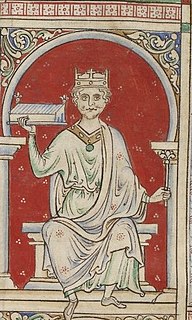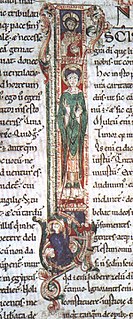Related Research Articles

Pope Alexander II, born Anselm of Baggio, was the head of the Roman Catholic Church and ruler of the Papal States from 1061 to his death in 1073. Born in Milan, Anselm was deeply involved in the Pataria reform movement. Elected according to the terms of his predecessor's bull, In nomine Domini, Anselm's was the first election by the cardinals without the participation of the people and minor clergy of Rome.

Pope Urban II, otherwise known as Odo of Châtillon or Otho de Lagery, was the head of the Catholic Church and ruler of the Papal States from 12 March 1088 to his death. He is best known for initiating the Crusades.

William II, the third son of William the Conqueror, was King of England from 26 September 1087 until his death in 1100, with powers over Normandy, and influence in Scotland. He was less successful in extending control into Wales. William is commonly referred to as William Rufus, perhaps because of his ruddy appearance or, more likely, due to having red hair as a child that grew out in later life.
William de Corbeil or William of Corbeil was a medieval Archbishop of Canterbury. Very little is known of William's early life or his family, except that he was born at Corbeil, south of Paris, and that he had two brothers. Educated as a theologian, he taught briefly before serving the bishops of Durham and London as a clerk and subsequently becoming an Augustinian canon. William was elected to the See of Canterbury as a compromise candidate in 1123, the first canon to become an English archbishop. He succeeded Ralph d'Escures who had employed him as a chaplain.
Ralph d'Escures was a medieval abbot of Séez, bishop of Rochester and then archbishop of Canterbury. He studied at the school at the Abbey of Bec. In 1079 he entered the abbey of St Martin at Séez, and became abbot there in 1091. He was a friend of both Archbishop Anselm of Canterbury and Bishop Gundulf of Rochester, whose see, or bishopric, he took over on Gundulf's death.
Thurstan or Turstin of Bayeux was a medieval Archbishop of York, the son of a priest. He served kings William II and Henry I of England before his election to the see of York in 1114. Once elected, his consecration was delayed for five years while he fought attempts by the Archbishop of Canterbury to assert primacy over York. Eventually, he was consecrated by the pope instead and allowed to return to England. While archbishop, he secured two new suffragan bishops for his province. When Henry I died, Thurstan supported Henry's nephew Stephen of Blois as king. Thurstan also defended the northern part of England from invasion by the Scots, taking a leading part in organising the English forces at the Battle of the Standard (1138). Shortly before his death, Thurstan resigned from his see and took the habit of a Cluniac monk.
Ranulf Flambard was a medieval Norman Bishop of Durham and an influential government minister of King William Rufus of England. Ranulf was the son of a priest of Bayeux, Normandy, and his nickname Flambard means incendiary or torch-bearer, and may have referred to his personality. He started his career under King William I of England, probably in the compilation of the Domesday Book of 1086, as well as being the keeper of the king's seal. On the death of William I, Ranulf chose to serve the new king of England, William Rufus.

William de St-Calais was a medieval Norman monk, abbot of the abbey of Saint-Vincent in Le Mans in Maine, who was nominated by King William I of England as Bishop of Durham in 1080. During his term as bishop, St-Calais replaced the canons of his cathedral chapter with monks, and began the construction of Durham Cathedral. In addition to his ecclesiastical duties, he served as a commissioner for the Domesday Book. He was also a councilor and advisor to both King William I and his son, King William II, known as William Rufus. Following William Rufus' accession to the throne in 1087, St-Calais is considered by scholars to have been the new king's chief advisor.
Gerard was Archbishop of York between 1100 and 1108 and Lord Chancellor of England from 1085 until 1092. A Norman, he was a member of the cathedral clergy at Rouen before becoming a royal clerk under King William I of England and subsequently his son King William II Rufus. Gerard was appointed Lord Chancellor by William I, and he continued in that office under Rufus, who rewarded him with the Bishopric of Hereford in 1096. Gerard may have been with the king's hunting party when William II was killed, as he is known to have witnessed the first charter issued by the new king, Henry I of England, within days of William's death.

Thomas of Bayeux was Archbishop of York from 1070 until 1100. He was educated at Liège and became a royal chaplain to Duke William of Normandy, who later became King William I of England. After the Norman Conquest, the king nominated Thomas to succeed Ealdred as Archbishop of York. After Thomas' election, Lanfranc, Archbishop of Canterbury, demanded an oath from Thomas to obey him and any future Archbishops of Canterbury; this was part of Lanfranc's claim that Canterbury was the primary bishopric, and its holder the head of the English Church. Thomas countered that York had never made such an oath. As a result, Lanfranc refused to consecrate him. The King eventually persuaded Thomas to submit, but Thomas and Lanfranc continued to clash over ecclesiastical issues, including the primacy of Canterbury, which dioceses belonged to the province of York, and the question of how York's obedience to Canterbury would be expressed.
Thomas II was a medieval archbishop of York.
William Warelwast was a medieval Norman cleric and Bishop of Exeter in England. Warelwast was a native of Normandy, but little is known about his background before 1087, when he appears as a royal clerk for King William II. Most of his royal service to William was as a diplomatic envoy, as he was heavily involved in the king's dispute with Anselm, the Archbishop of Canterbury, which constituted the English theatre of the Investiture Controversy. He went several times to Rome as an emissary to the papacy on business related to Anselm, one of whose supporters, the medieval chronicler Eadmer, alleged that Warelwast bribed the pope and the papal officials to secure favourable outcomes for King William.
Robert the Lotharingian was a priest who became Bishop of Hereford following the Norman Conquest of England. His writings serve as one of the best sources for information on the process of compiling the Domesday Book, and he may have introduced the abacus to England.

Ralph de Luffa (or Ralph Luffa was an English bishop of Chichester, from 1091 to 1123. He built extensively on his cathedral as well as being praised by contemporary writers as an exemplary bishop. He took little part in the Investiture Crisis which took place in England during his episcopate. Although at one point he refused to allow his diocese to be taxed by King Henry I of England, Luffa remained on good terms with the two kings of England he served.
Seffrid I, sometimes known as Seffrid Pelochin, was a medieval Bishop of Chichester.
Robert de Limesey was a medieval cleric. He became Bishop of Chester in 1085, then his title changed to Bishop of Coventry when the see was moved in 1102.
Reynelm was a medieval Bishop of Hereford.

Anselm of Canterbury, also called Anselm of Aosta after his birthplace and Anselm of Bec after his monastery, was an Italian Benedictine monk, abbot, philosopher and theologian of the Catholic Church, who held the office of Archbishop of Canterbury from 1093 to 1109. After his death, he was canonized as a saint; his feast day is 21 April.
The Canterbury–York dispute was a long-running conflict between the archdioceses of Canterbury and York in medieval England. It began shortly after the Norman Conquest of England and dragged on for many years. The main point of the dispute was over whether Canterbury would have jurisdiction, or primacy, over York. A number of archbishops of Canterbury attempted to secure professions of obedience from successive archbishops of York, but in the end they were unsuccessful. York fought the primacy by appealing to the kings of England as well as the papacy. In 1127, the dispute over the primacy was settled mainly in York's favour, for they did not have to submit to Canterbury. Later aspects of the dispute dealt with concerns over status and prestige.
Events during the year 1101 in Italy.
References
- Barlow, Frank (1988). The Feudal Kingdom of England 1042–1216 (Fourth ed.). New York: Longman. ISBN 0-582-49504-0.
- Barlow, Frank (1983). William Rufus. Berkeley: University of California Press. ISBN 0-520-04936-5.
- Cantor, Norman F. (1958). Church, Kingship, and Lay Investiture in England 1089–1135. Princeton, NJ: Princeton University Press. OCLC 186158828.
- Mason, Emma (2005). William II: Rufus, the Red King. Stroud: Tempus. ISBN 0-7524-3528-0.
- Robinson, Ian Stuart (1990). The Papacy, 1073–1198: Continuity and Innovation. Cambridge, UK: Cambridge University Press. ISBN 0-521-31922-6.
- Southern, R. W. (1990). Saint Anselm: A Portrait in a Landscape. Cambridge: Cambridge University Press. ISBN 0-521-36262-8.
- Vaughn, Sally N. (1987). Anselm of Bec and Robert of Meulan: The Innocence of the Dove and the Wisdom of the Serpent. Berkeley: University of California Press. ISBN 0-520-05674-4.